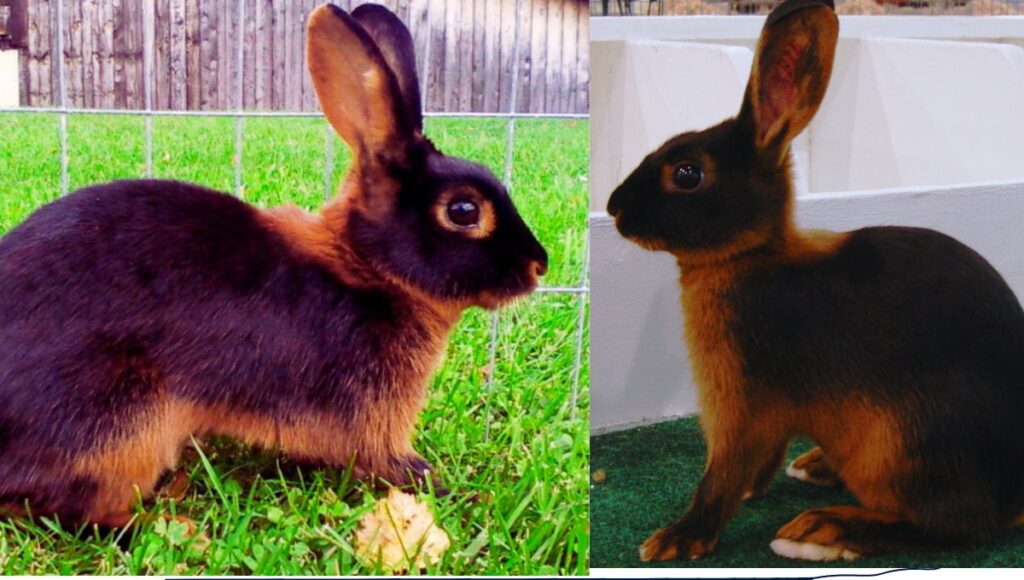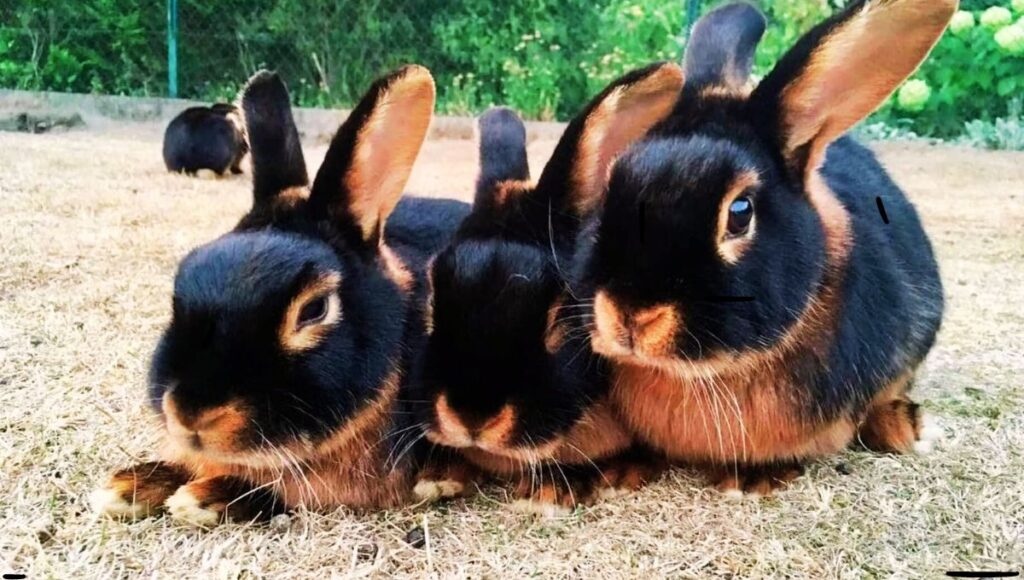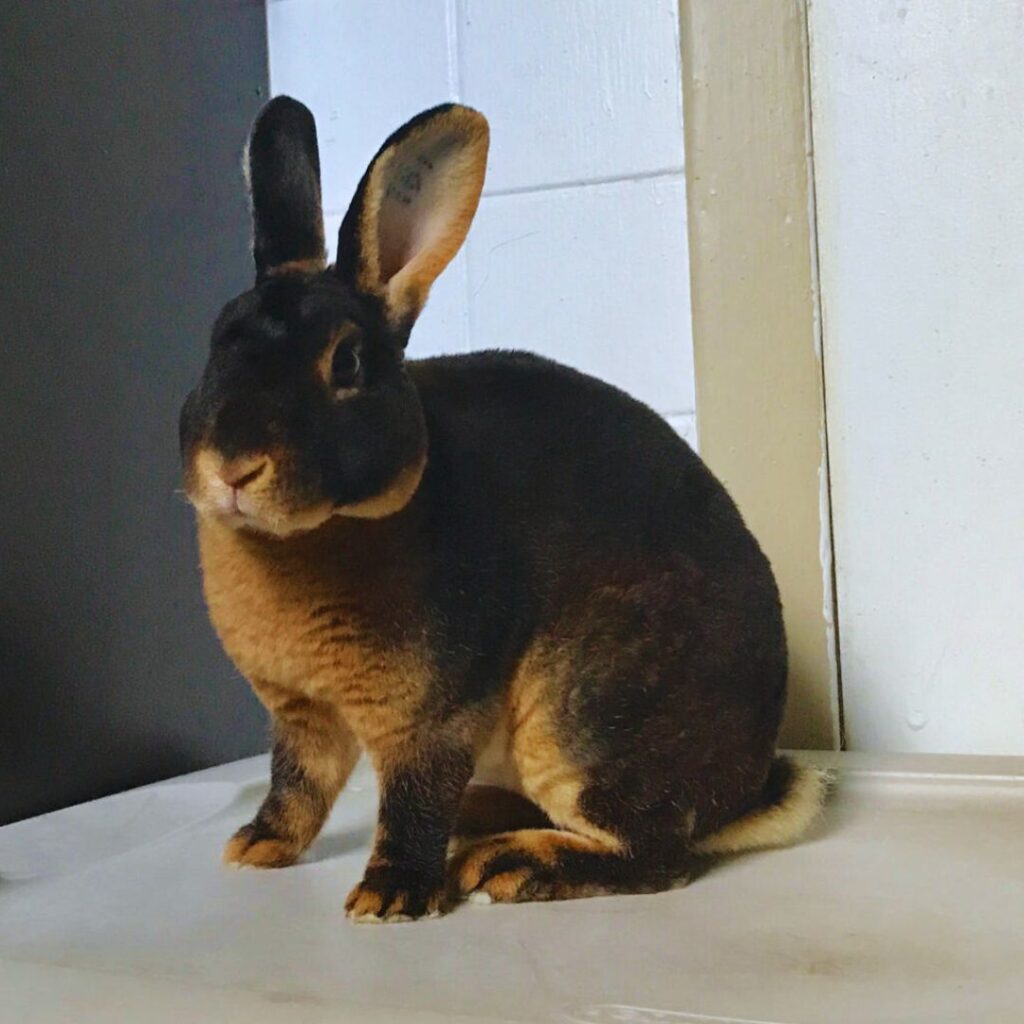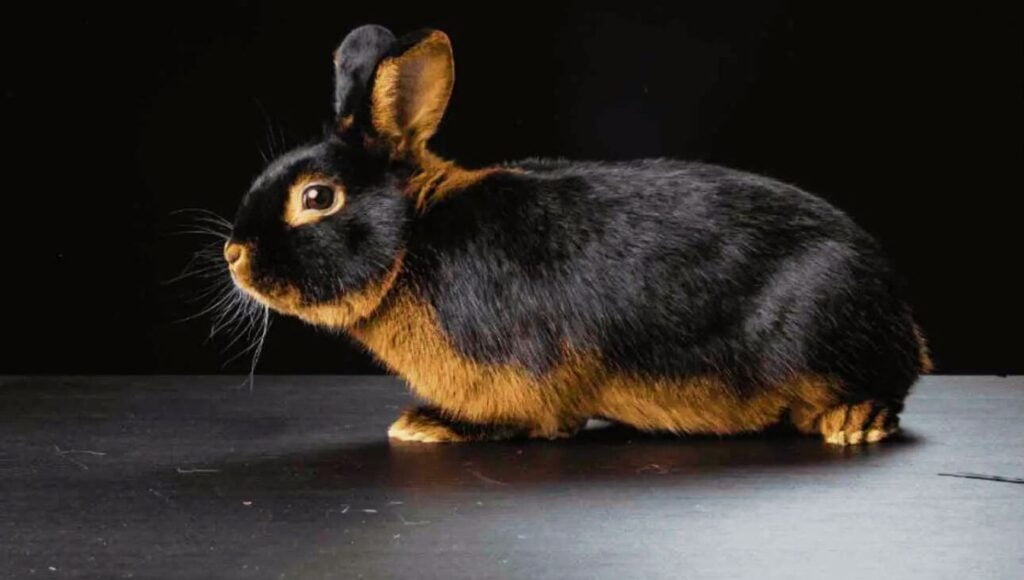Known for its docile and friendly demeanour, Tan rabbits are found all over the world. Tan rabbits are a small and fancy breed of rabbits which is known for their attractive fur.

Table of Contents
Tan Rabbits- In a Glimpse:
| Common Name | Tan Rabbits |
| Scientific Name | Oryctolagus cuniculus |
| Other Names | The Black and Tan Rabbit |
| Adult Weight | 4.5-6 lbs |
| Behaviour | Black, Blue, Chocolate, and Lilac. |
| Habitat | Cage, hutches, meadows |
| Diet | Grass, Hays, Oats, Spinach, etc |
| Predators | Dogs, cats, foxes, badgers, etc |
| IUCN Status | Not evaluated |
| Gestation Period | 28-31 days |
| Weaning Age | 1.5-2 months |
| Lifespan | 8-10 Years |
| Behavior | Docile, gentle, playful, and intelligent |
| Good Pets? | Yes |
| Jump | 36 inches |
| Speed | 40 mph |
Everything About Tan Rabbits:
The Tan rabbits are a very beautiful, adorable, small, and energetic pet rabbit breed that is known for its lean, arch body type and enthusiastic personality.
Origin:
Tan rabbits originated in the United Kingdom (Derbyshire) in 1887 and quickly became popular among the rabbit breeders. It was a product of mixing European wild rabbits and a domestic rabbit but the challenge was difficult in achieving the consistency of form, colour, and behaviour of a domestic rabbit. However, in 1908, the rabbit breed gained popularity in the USA.
Habitat:
Tan rabbits don’t have any specific habitat. As they are used mostly as domestic pets, owners can keep them in cages, or hutches (if kept outdoors). However, the owner must ensure the rabbit has enough space inside the cage or hutch to move, play with toys, and exercise.
The rabbits are fickle by nature. If you don’t give it enough attention, the rabbit tends to run outside and play in the garden, park, or even in bushes or meadows. Hence, you have to be watchful and protect your rabbit from every possible threat.
Physical Appearances: What does a Tan Rabbit look like?

Initially, Tan rabbits had a cobby build and compact type body and they were known as the Black and Tan breed of rabbits due to their body structure and unique colouration. Soon the size was decreased and made the rabbit perfect for exhibition and shows.
Sexual dimorphism is present in the Tan rabbits as females are slightly bigger than the males. The highly energetic and active rabbit weighs around 4-5.5lb (1.8-2.5kg) for a male and around 6lb (2.7kg) for a female.
Due to their graceful and stunning appearances, Tan rabbits are also known as “Aristocrat Rabbits”. The lean and well-balanced rabbit breed has a compact full-arch body shape with large erect ears standing tall on its head. The Tans are more similar to Belgian Hare by their appearance.
Fur and Colour:
Tan rabbits have sleek and shiny rollback fur which means when it is strokes from opposite sides, it returns to the original position. The colour combination of the rabbit is similar to a Doberman Pinscher dog, which gives the breed a breathtaking appearance.
The fur is thick, medium-fine, springy flyback. The American Rabbit Breeders Association (ARBA), has recognized four colour varieties for the Tan rabbits: Black, Blue, Chocolate, and Lilac. The colour combined with an unbroken solid colour of rich tan from its chin, under its midsection through to its tail, and in its ears and around its eyes.
Diet:

Similar to other domestic rabbit breeds, 70% diet of Tan rabbit should consist of highly nutritious hay (timothy hay) mixed with grasses. The remaining 30% of their diet should consist of fruits, herbs, and green vegetables (such as spinach, beans, broccoli, leaves, etc).
You must ensure that the diet should be high in fibre and has low sugar content. The diet must fulfil the rabbit’s essential minerals, vitamins, and other important elements requirement. However, you can also feed them with commercial rabbit foods. Professional breeders recommend half a cup of pellets once a day.
Predators and Threats:
The small rabbit breed doesn’t have any natural predators. But while playing outdoors, the owner must protect the rabbit from every potential threat. The rabbit is known for its delicious meat and hence dogs, cats, wolves, foxes, badgers, coyotes, and larger birds can attack and harm them while playing outdoors.
IUCN Status:
IUCN hasn’t evaluated the conservation status of the Tan rabbit due to the unavailability of data.
Also Read: Lionhead Rabbits: Everything You Must Know Before Buying
Reproduction:

However, Tan rabbits are found in four colour varieties (Black, Blue, Chocolate, and Lilac), but professional breeders suggest staying within one colour group until one becomes more familiar with colour genetics. There are two informal colour groups, such as Black-Blue, and Chocolate-Lilac as blue is the recessive of black and lilac is the recessive of chocolate. Hence, according to the breeder, a beginner should breed only between either black and black or black and blue and the same between lilac and chocolate.
The average litter size of Tan rabbits is four and the babies are born healthy as the rabbits usually don’t have any genetic defects. The babies are hyperactive and as a result, they often jump out of the box. The babies are raised with constant handling and the less human presence is better while the mother raises her babies.
Life Expectancy:
The Tan rabbits have a lifespan of 8-10 years. If the rabbit is healthy enough, sometimes they can live up to 12 years.
Behaviour: Are Tan Rabbits Good Pets?
Tan rabbits are highly active, gentle, and playful. These rabbits are known as the Aristocrats of the Fancy rabbits due to their colourful coat. The rabbits have worldwide popularity as exhibition rabbits and often they can win the first prize as well.
The nature of a Tan is affectionate, playful, and curious and sometimes they are a busy hopper as well. They are highly active but not aggressive. Aggressiveness indicates an underlying health problem or injury to the rabbit.

However, Tan rabbits are known for their beautiful sheen and unusual fur colouration, but they also possess high intelligence and learning abilities. It may seem shy in the beginning but if you show them how to socialize, the rabbit can socialize pretty easily. Tans can adjust to family members very easily irrespective of their age, gender and experience.
Tan rabbits are more active during daybreak and sunset. If you allow them to run around your house, they’ll investigate and chew things. Hence, it is recommended to keep all electric wires, sharp objects, important documents, and clothes out of the rabbit’s reach.
The owner must allow the rabbit to play outside the house, in the garden for 3-4 hours daily and breathe the fresh air to maintain their health and energy level. However, you must ensure that the Tan is safe outdoors from potential predators and monitor it closely while playing in the garden.
Speed and Jump:
Tan rabbits can run at a speed of 40 mph or 64 kmph. The rabbits can jump very well. Sometimes they can jump more than 36 inches (91.4 cm).
About Tan Rabbit Sales:
How do you purchase a Tan Rabbit?
Tans are one of the most popular rabbit breeds around the world. Hence, you can easily find them in your local pet shops or you can purchase them from your local rabbit breeders. However, depending on your location you can also buy them online. In case you haven’t found a rabbit breeder yet, you can click here and find a rabbit breeder that is certified by ARBA.
How much does a Tan Rabbit cost?
The price of Tan rabbits depends on your location. In the USA, the price of a Tan varies between $30 and $100. But a Tan ready for exhibition can also cost up to $400. Don’t forget to check the health and genetic history of the rabbit before buying.
Cage Size:
Just like other domestic rabbits, the bigger the cage size is the better for a rabbit. It is recommended the cage must be 3-4 times the rabbit’s size. If you lack space at your home, the cage size should be at least 24 inches wide by 24 inches high by 36 inches long.
7 facts to know before buying a Tan Rabbit:
- Tan rabbits are intelligent and very easy to train. You can easily give a crate (so the rabbit returns to the cage/hutch to relax) and potty training to the rabbit. Ensure the litter box is far from the feeding place and should be cleaned once a week.
- The rabbits can be infected by flystrike (when a fly lands on a rabbit’s skin and lays their eggs in the rabbit’s skin), Spaying or neutering, Bladder Sludge (Calcium from their diet stored in the bladder), urinary tract infections (UTIs), etc. If the rabbit is infected then it might act aggressively and bite.
- The rabbits need grooming once a week but during moulting season it is advised to groom them thrice a week. Similar to other rabbits, Tans can’t vomit and hence if they consume their fur, it will cause GI Stasis which is dangerous for them.
- Tan rabbits usually self-clean their fur. Don’t bathe them unless they are very dirty. Bathing can be a horrible experience for them.
- You should clean their nails, teeth, and ears to protect them from dirt. Otherwise, flies can lay eggs on their ears and may cause flystrikes. Ears control their body temperature. Hence, it is very important to keep ears clean.
- A rabbit’s teeth never stop growing and sometimes it grows into their jaws and face which is very painful and prevents them from eating. Hence, always check their teeth and if you find an overgrown tooth, it should be filed down by a veterinarian. Chewing hay also prevents teeth from overgrowing.
- The Tan rabbits must need 3-4 hours of exercise in the ground/garden every day. This exercise may consist of running, jumping, digging, and playing. While playing outside, you must monitor the rabbit closely otherwise many predators like cats, dogs, foxes, badgers etc might harm them for their meats.
FAQs:
Are Tan Rabbits Aggressive?
No, Tan Rabbits are not aggressive. But if you provoke them, then they can bite. Apart from that, if the rabbits are injured or in mating season, especially the female can show some aggressiveness.
Also Read:
Are Mini Lop Rabbits Good Pets? 7 Important Facts to Know Before Buying
Are Polish Rabbits Good Pets? 13 Interesting Facts to Know Before Purchasing
Are Satin Rabbits Good Pets? 17 Facts to Remember Before Purchasing a Satin
Are Rex Rabbits Good Pets? 13 Facts You Should Know Before Purchasing a Rex
English Spot Rabbit: Everything You Should Know Before Purchasing